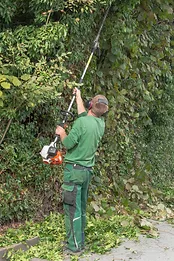
The mild winters of the Southeastern United States make for the perfect conditions for plants of all kinds to thrive. Georgia’s vegetation makes for scenic views and beautiful greenery, but for some common invasive plants, that beauty comes at a cost. Invasive plants harbor pests, starve out native plants and crops, and lead to flooding. Each species comes with its own risks.
Kudzu
This fast-growing vine may be one of the most familiar invasive plant species in the United States. It seems to be everywhere, growing up lamp posts and along telephone lines, or all but drowning out the native trees of Georgia’s old growth forests along highways. Though it first arrived in the state as part of a project to control erosion, it has been designated a weed since 1970 and the state has made an effort to eliminate it for about as long.
The only way to prevent these issues is to kill any kudzu on your property. Hardy and drought-resistant, the very characteristics that first made kudzu so appealing as a potential agricultural solution, are the same ones that make kudzu such a nuisance. Once the plant has been established, it can take years of persistence to eradicate it from a property. Yet, if it is allowed to grow, it will do so by choking out any natural or agricultural vegetation in its path. It is able to knock down trees and cause downed wires. It also lowers property values.
Japanese Honeysuckle
Known to reach over 80 feet long, the ornamental Japanese honeysuckle is all but ubiquitous throughout Georgia. The beauty and fragrance of its flowers make it a popular choice for hobby gardeners, but without proper care, Japanese honeysuckle can quickly grow out of control. It grows quickly and crowds out other plants wherever they grow, eating up nutrients so that all other vegetation dies out. Although they might start out as a pretty addition to a garden, before long, Japanese honeysuckle plants will turn into weeds that must be killed.
Japanese honeysuckle vines can climb and cover structures like fences, trees, and buildings, potentially causing damage or weakening their structural integrity. It has been known to strangle tall trees, ultimately killing those trees and causing them to fall on nearby structures, costing thousands of dollars in damages. Eradication is important in order to prevent this, as well as to ensure that other plants are able to survive in the same environment.
Privet
Another problematic invasive plant is the Chinese privet. Unlike kudzu or Japanese honeysuckle, which grow as vines, privet grows more like a bush. A single privet shrub can reach around 30 feet in height. It can tolerate a wide variety of conditions, allowing it to spread quickly. Though its flowers are pretty, privet produces an unpleasant odor, and its berries are poisonous to both humans and animals, including household pets.
One of the biggest problems with privet is that, especially along riverbanks or near streams and creeks, it can cause erosion, which leads to increased flooding. Though it can grow just about anywhere, it prefers these moist conditions. This can result in huge financial issues down the road, especially for buildings situated in areas already prone to flooding. Removal is difficult but necessary in order to avoid potential water damage, as well as to prevent competition with native plants or crops.
Invasive Weed Control
If these or other invasive plants are encroaching onto your property and becoming a problem for you and your customers, consider Ground Force for necessary weed control. We are committed to eco-friendly vegetation management and offer a wide range of services that can help keep your property weed-free and beautiful.
References
https://site.extension.uga.edu/forsyth/2023/07/invasive-plant-profile-kudzu/
https://gatrees.org/wp-content/uploads/2020/02/Invasive-Plants-of-Georgia-Forests.pdf
https://www.ajc.com/life/5-invasive-plants-taking-over-georgia-in-2022/Z6U5GSODLVF3JF6YLRZBTCEKTI/



